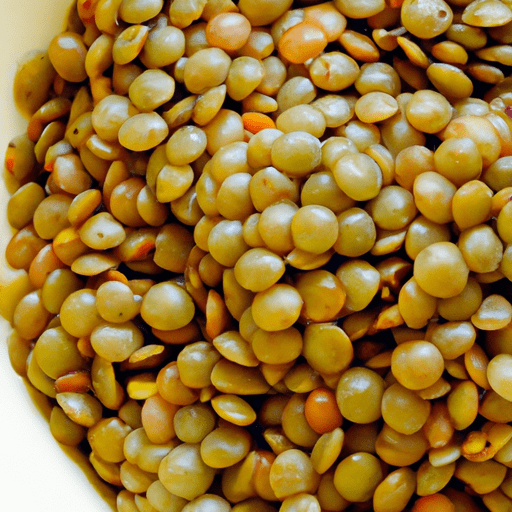The Versatile and Protein-Packed Powerhouse: Cooked Lentils
Lentils, those tiny legumes found in various cuisines across the globe, have been embraced by home cooks and chefs alike for their incredible versatility, delicate flavors, and impressive nutritional profile. Whether you’re a vegetarian, vegan, or simply looking to boost your protein intake, cooked lentils are an excellent addition to your culinary repertoire. In this blog post, we’ll explore everything you need to know about cooked lentils, from their taste and common uses in cooking to their nutritional benefits and intriguing history. So, let’s dive in!
A Taste for Every Palate
Cooked lentils offer a delightful taste and texture that can suit a wide range of dishes. With a mild earthy flavor and a tender yet slightly firm consistency, they can be a fantastic base for various recipes. One of the great attributes of lentils is their ability to absorb flavors, making them an ideal ingredient for hearty stews, soups, curries, salads, and even veggie burgers. Whether cooked with aromatic spices or combined with fresh herbs and tangy dressings, lentils adapt well to both bold and subtle flavors.
The Culinary Chameleon
The culinary world is no stranger to the incredible versatility of cooked lentils. Found in diverse cuisines such as Indian, Middle Eastern, Mediterranean, and Latin American, lentils are a staple ingredient in countless recipes. In Indian cuisine, lentils are transformed into comforting and aromatic dal, while in the Mediterranean, they star in hearty salads and soups like the famous Italian dish, lentil minestrone. Lentils can also step up as a protein substitute in vegetarian and vegan dishes, adding heartiness to grain bowls, tacos, and more. Their adaptability is a culinary dream come true, as they effortlessly elevate any recipe they encounter.
Nutritional Bonanza
Beyond their delectable taste and culinary diversity, cooked lentils pack a serious nutritional punch. These legumes are an excellent source of plant-based protein, making them a valuable addition to vegetarian and vegan diets. A one-cup serving of cooked lentils provides a whopping 18 grams of protein, along with a generous amount of dietary fiber, iron, folate, and manganese. Lentils are also low in fat and cholesterol, making them a heart-healthy food choice. They have a low glycemic index, helping to regulate blood sugar levels and provide lasting energy. Lentils are a beacon of nutrition, ticking many boxes for those seeking a well-rounded and wholesome diet.
A Journey Through Time
Lentils have stood the test of time, with their cultivation dating back over 8,000 years. Native to the Near East, lentils quickly spread across Europe, Asia, and eventually found their way to the Americas. They hold a special place in history, mentioned in the Bible as a food that satisfied the hungry stomach of Esau. Consumed by people of different cultures and religions, lentils have been cherished for their high nutritional value and storage stability. Today, lentils continue to make their mark in global cuisine, captivating food enthusiasts with their versatility and nourishment.
Fun Facts about Lentils
- Lentils come in various colors, including green, brown, black, red, and yellow. Each type offers a slightly different taste and texture, allowing for endless culinary possibilities.
- The United Nations declared the year 2016 as the International Year of Pulses, highlighting the importance of lentils and other legumes in sustainable food systems.
- Lentils require no pre-soaking, making them a quick and convenient ingredient to cook with.
- Lentils are environmentally friendly, as they require less water and fossil fuel than many other protein sources, contributing to sustainable agriculture.
Cooked lentils are truly a gift from nature. From their humble beginnings to their place on dinner tables around the world, lentils have proven to be a culinary staple. With their delicate taste, adaptability in various dishes, impressive nutritional value, and rich history, cooked lentils deserve a prominent place in our kitchens. So, next time you’re looking for a nourishing and versatile ingredient, don’t forget to reach for these protein-packed powerhouses!
What are your favorite dishes made with cooked lentils? Share your recipes and experiences in the comments below!
Cooked Lentils
Origin: Lentils are believed to be one of the first cultivated crops in human history, dating back over 10,000 years. They originated in the Near East and were consumed by the ancient Sumerians, Egyptians, and Greeks.
Common Uses: Cooked lentils are versatile and commonly used in various cuisines around the world. They are often added to soups, stews, and curries, enhancing both flavor and texture. In many cultures, lentils are used to make spreads, such as dal in Indian cuisine or hummus in the Middle East. They can also be used to make vegetarian burgers, salads, and even desserts.
Nutritional Benefits: Lentils are highly nutritious. They are an excellent source of plant-based protein, fiber, and complex carbohydrates. Additionally, they are rich in various vitamins and minerals, including folate, iron, and magnesium. Lentils are also low in fat and contain no cholesterol, making them a healthy choice for those following a balanced diet.
Unique Properties: One of the unique properties of lentils is their ability to cook relatively quickly compared to other legumes. This is because they have a thin seed coat and don’t require pre-soaking. Their texture can range from soft and mushy when fully cooked, to firm and slightly crunchy when cooked al dente. They come in different colors, including green, brown, red, and black, with slightly varying flavors and cooking times.
Historical Significance: Lentils have a long history and have been an important staple food for many civilizations. In ancient times, they were considered a valuable source of sustenance due to their high nutritional content and long storage life. Lentils were even mentioned in the Bible, associating them with periods of fasting and sacrifice.
Remember to always follow proper cooking instructions and guidelines when preparing lentils to ensure they are thoroughly cooked and safe to consume.




Use the share button below if you liked it.
It makes me smile, when I see it.